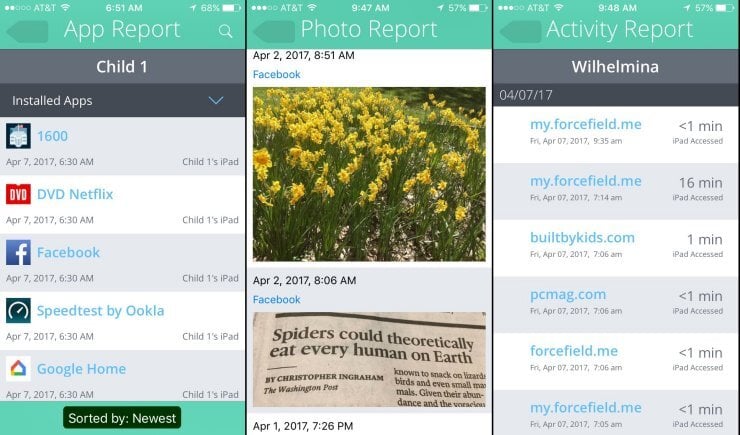
ForceField gives iPhone parents some control over their kids’ activities on iOS and macOS devices, but some features didn’t work well in our tests and the price is much lower than the competition. When today’s kids focus only on their devices, a desktop-centric parental control system is outdated and irrelevant. ForceField focuses primarily on mobile devices and offers apps for parents and children. It works on iOS (there’s no Android app), but can also support your child’s Mac account.
While it does some things well, I also found some features that didn’t work in my testing, and the price is much lower than the competition. For $11.99 per month, you get two parent accounts and one child account, with no limit on the number of iOS devices per child. Each additional child is $3.00 per month. It is expensive.For 12 months of service you pay $143.88. The only more expensive iOS parental control tool I’ve tested is Xnspy (for iPhone) at $149.99 per year.
Many similar tools cost less than $50 per year. Editor&039; Choose Kaspersky Safe Kids (for iPhone) ($0.00 at Apple.com) to protect any number of children on any number of devices for just $14.99 per year. Correct.For $14.99, ForceField lets you monitor two children for a month. With Kaspersky Safe Kids you can monitor as many children as you want all year round. And while ForceField only covers iOS and macOS, Kaspersky offers additional protection for Windows and Android. Getting Started with ForceField Not surprisingly, the first step is to connect to the Internet and create an account.I suggest you try the product free for 30 days and see if it meets your needs.
During the registration process, you can add the other parent’s contact information and add your child to the account. I did this online, but you can also do it in the ForceField iOS app. There is a guided setup option that will walk you through the initial setup steps. If the steps seem even a little daunting, concierge setup help is available.You can schedule an appointment with a ForceField installation expert who will walk you through all the necessary steps. I installed the main app on my Apple iPhone 6 (from Amazon) without any problems. This is an app for children that can encourage parents to ask for help.
Installing the Kids App For testing purposes, I installed the Kids app on my Apple iPad Air ($389.99 on eBay). To install an app on your child’s device, you don’t just have to go to the App Store. Instead, you navigate to a special URL where a wizard walks you through all the necessary steps. You’ll first be asked to confirm that you have your child’s device unlock code and Apple ID credentials.Next, you’ll also need your child’s social media contacts. Also note that you must use Safari for this process. I tried to do this with Chrome but it crashed. Like Kaspersky and Familoop, ForceField uses mobile device management (MDM) to control your child’s iOS devices. Although MDM was designed to allow companies to control corporate devices, it is also very effective when it comes to parental control settings.The wizard warns you that you will need to see a series of warnings and prompts to enable MDM. During this process you will also need to enter your device password.
ADS
After activating the MDM profile, the wizard continues the installation process. You will need to confirm the installation and provide the appropriate Apple credentials. Deleting a Kaspersky MDM profile requires a code that you receive from your online account.ForceField offers no protection. However, you will be notified if your child deactivates ForceField by deleting their profile. App Sleeper When first launched, the ForceField subapp warns that using App Sleeper may result in apps being listed alphabetically on the home screen and removed from folders. It’s an annoying phenomenon, but it happens when you use MDM to remove access to applications. FamilyTime Premium (for iPhone) (free on Apple.com) had the same issue when I turned App Lock on and off.The behavior comes from Apple, not the app.
What is the Sleeper app? When called up, the icons of all apps available on iOS except for a few are hidden. During testing, I found that the only remaining apps were Calendar, Photos, Contacts, Clock, Maps, Home, TV, Notes, Reminders, Settings, App Store, Messages, Email, and Music. I couldn’t even take a screenshot of the home screen. The purpose of App Sleeper is to reduce distractions when your child needs to focus on something important, such as doing homework. From the parent app, you can access it manually at any time and reactivate apps when you don’t have time for homework. You can also set a timer so that apps start automatically after a certain number of hours or minutes. If you want, you can set a daily schedule for App Sleeper, for each day individually, for every day or for school evenings. The schedule allows you to set a single time slot, i.e. H. For example, you can’t set it to turn on again and again before bed while you’re doing homework.
The first browser rules setting determines whether your child can use Safari. ForceField specifically states that if you allow the use of Safari, it will not be able to track or control your child’s Internet browsing. Be sure to disable Safari. Once you’re done, Safari will simply disappear from your child’s device. For complete control and monitoring, you need to uninstall Chrome and other browsers from your child’s device. Again, an enterprising child could avoid persecution by, for example, posting a link in the Facebook app and then accessing that link in the app.
It is very common in iOS based parental control systems to require you to use your own browser. Norton, Net Nanny, and many others provide detailed instructions telling parents how to disable other browsers using restrictions in the Settings app. ForceField doesn’t do that. Familoop Safeguard (for iPhone) is rare; Since it installs a VPN, it can filter all your internet traffic. Qustodio also offers VPN-based filtering, although this is a separate and cumbersome setup. Once other browsing options are disabled, your child must use ForceField to access the Internet.
With the least amount of control and without enabling the blocking feature, you can force restricted mode on YouTube and force safe searches on Google, Bing and Yahoo. If blocking is enabled, the first time your child tries to visit a website, you will instead see a warning with a link that your child can use to request access.
ADS
This will immediately generate a notification in the parent app with a preview of the page and links that the parent can tap to allow or deny access. Once the website is approved, your child can visit it freely. ForceField also includes a library of over 400 curated, kid-friendly educational sites.By default they are not blocked. However, you can configure it so that selected websites also require parental consent.
There is another level of navigation control and it is brutal. With just one click you can stop internet access in your ForceField browser. This does not affect any other applications, only ForceField. The child can submit an online timeshare request via the application menu.This request generates a parental notification where parents can choose whether to deny the request or allow it for a specific period of time. However, during testing, I found that this feature does not work.
Even when I complied with the time request, the downstream application did not respond. A company contact confirmed that this is a known issue. Activity Report and Application Report The ForceField Activity Report simply lists all the websites your child has visited.In my testing, instances of the URL my.forcefield.me, which represents the ForceField homepage, dominated the list. I suggested to a contact at my company that they consider removing this URL from the report.
In the parent app, tap App Report to see a list of all apps installed on your child’s device. You can tap an app to view it in the App Store, but that’s all. You cannot block or uninstall a specific application. Honestly, this level of app management doesn’t seem possible on iOS. It’s more of an Android problem. Photo Report You might think that a photo report would show photos taken with the camera app, but that’s not the case.
In particular, the photo report allows you to see every photo your child posts on Facebook, Google+, Instagram, Twitter or Tumblr. To enable this feature on a specific social network, you must have your child’s login credentials for that network. If a smart child deletes the ForceField application, it will mean the end of the photo story, although you will receive a notification about your child’s harassment.



